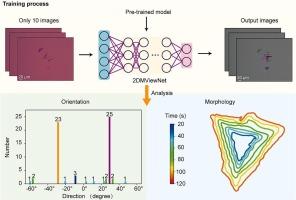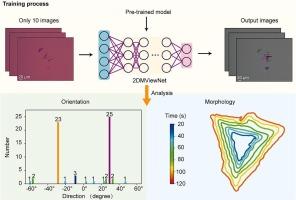有效单层识别的数据增强辅助迁移学习
IF 6.9
2区 材料科学
Q2 CHEMISTRY, PHYSICAL
引用次数: 0
摘要
通过机械剥离或化学气相沉积(CVD)合成的单分子膜的快速和精确识别对于研究二维(2D)材料至关重要。然而,传统的表征技术通常依赖于大量的人工分析和大规模的带注释的数据集,这限制了它们在实时监测和形态分析中的效率。在这项工作中,我们提出了一种深度学习辅助方法,称为二维材料视图神经网络(2DMViewNet),旨在使用最少数量的训练样本进行有效的单层识别和晶体取向分析。利用数据增强辅助迁移学习,2DMViewNet仅使用10个训练图像就可靠地识别单层样本。此外,提出了一种自动算法,通过提取深度图像特征来分析三角形单层的方向,为生长动态提供关键见解。为了进一步探索晶体生长的基本机制,2DMViewNet与原位光学观测微cvd系统相结合,实时研究晶体生长过程。这项工作不仅为单层识别提供了一种快速和数据高效的方法,而且为探索二维材料生长的基本机制提供了一个强大的工具,最终促进了下一代纳米材料的发展。本文章由计算机程序翻译,如有差异,请以英文原文为准。


Data augmentation-assisted transfer learning for efficient monolayer recognition
The rapid and precise identification of monolayers synthesized by mechanical exfoliation or Chemical Vapor Deposition (CVD) is essential for investigating two-dimensional (2D) materials. However, conventional characterization techniques typically rely on extensive manual analysis and large-scale annotated datasets, which constrain their efficiency in real-time monitoring and morphological analysis. In this work, we present a deep learning-assisted approach, termed the 2D Materials View Neural Network (2DMViewNet), designed for efficient monolayer recognition and crystal orientation analysis with a minimal number of training samples. Leveraging data augmentation-assisted transfer learning, 2DMViewNet reliably identifies monolayer samples using only 10 training images. Furthermore, an automated algorithm is proposed to analyze the orientations of triangular monolayers by extracting deep image features, providing critical insights into growth dynamics. To further explore the fundamental growth mechanisms, 2DMViewNet is integrated with an in-situ optical observation micro-CVD system for real-time investigation of the crystal growth process. This work not only provides a rapid and data-efficient approach for monolayer identification but also presents a powerful tool for probing the fundamental mechanisms underlying 2D material growth, ultimately facilitating the development of next-generation nanomaterials.
求助全文
通过发布文献求助,成功后即可免费获取论文全文。
去求助
来源期刊

Applied Surface Science
工程技术-材料科学:膜
CiteScore
12.50
自引率
7.50%
发文量
3393
审稿时长
67 days
期刊介绍:
Applied Surface Science covers topics contributing to a better understanding of surfaces, interfaces, nanostructures and their applications. The journal is concerned with scientific research on the atomic and molecular level of material properties determined with specific surface analytical techniques and/or computational methods, as well as the processing of such structures.
 求助内容:
求助内容: 应助结果提醒方式:
应助结果提醒方式:


